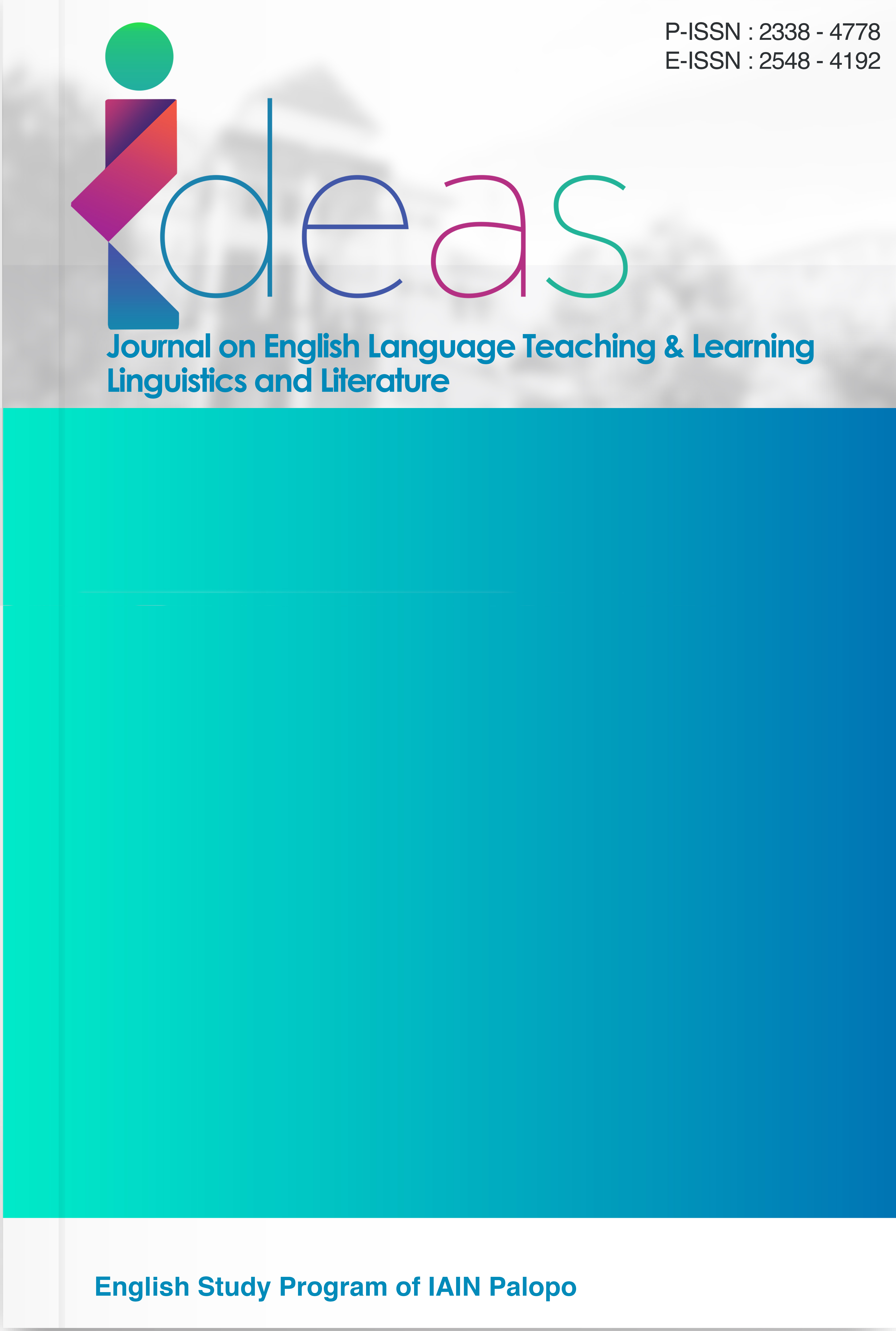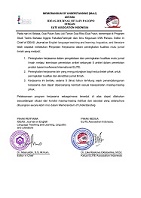Students` Perspectives on The Use of Preply Application in Reading Vocabulary Skills in Students
DOI:
https://doi.org/10.24256/ideas.v13i2.7200Keywords:
Vocabulary, Reading Skills, Digital Learning, Preply, Perception, EFL, Motivation, Technology IntegrationAbstract
This research examines how students view the Preply application as a tool for enhancing their English reading vocabulary skills, employing a qualitative case study approach. In total, there were 27 seventh-grade learners from a junior high school in Delitua who took part in the research. Information was collected through questionnaires administered before and after the study, as well as through semi- structured interviews. After utilizing Preply, students’ confidence in reading vocabulary saw an improvement of 0. 95 points on average. The results indicate that the features of Preply—such as its flexible accessibility, multimedia resources, and the availability of tutors—positively influenced student engagement, motivation, and self-sufficiency. Nevertheless, there were obstacles, including limited access to premium functionalities and insufficient integration with existing curricula. This research is based on the frameworks of Mobile-Assisted Language Learning (MALL) and Self-Determination Theory, providing valuable insights into incorporating digital tools into formal English education.
References
Afflerbach, P., & Cho, B.-Y. (2017). The classroom context of strategic reading. The Reading Teacher, 71(1), 5–14.
Ahmed, H. B. E. (2016). Duolingo as a bilingual learning app: A case study. Arab World English Journal (AWEJ) Volume, 7(2), 255–267.
Alrasheedi, M., Capretz, L. F., & Raza, A. (2015). A systematic review of the critical success factors for mobile learning. The Turkish Online Journal of Educational Technology, 14(2), 41–51.
Amelia, D., & Nurmaily, E. (2021). Upaya peningkatan kosakata bahasa Inggris melalui slide and sound storytelling. Journal of Social Sciences and Technology for Community Service (JSSTCS), 2(1), 22–26. https://doi.org/10.33365/jsstcs.v2i1.948
Apriliani, D. N. (2021). Students’ Perception in Learning English Vocabulary Through Quizlet. Journal of English Teaching, 7(3), 343-353.
Annisa, N., Syam, A. T., & Masruddin, M. (2022). Teaching vocabulary through the round robin brainstorming technique. English Education Journal, 13(1), 741-750.
Ar, N. A. E., & Syam, A. T. (2024). Increasing Students' Reading Skills Using Reading Box in Junior High School. IDEAS: Journal on English Language Teaching and Learning, Linguistics and Literature, 12(2), 1249-1260.
Baxter, P., & Jack, S. (2008). Qualitative case study methodology: Study design and implementation for novice researchers. The Qualitative Report, 13(4), 544–559.
Bozkurt, A. (2020). Educational technology research patterns in the realm of the digital knowledge age. Journal of Interactive Media in Education, (1), 1–17.
Burston, J. (2015) – A comprehensive review of MALL between 1994 and 2012. Cameron, L. (2001). Teaching languages to young learners. Cambridge: Cambridge University Press.
Campbell, S., Greenwood, M., Prior, S., Shearer, T., Walkem, K., Young, S., … Walker,
K. (2020). Purposive sampling: complex or simple? Research case examples.
Journal of Research in Nursing, 25(8), 652–661.
Cesarini, A. N., Sulaeman, N., Mulyana, S. S., & Yolandri, V. (2021). Utilizing Duolingo in learning vocabulary. Proceedings of the International Conference on Education of Suryakancana, 109–117. https://doi.org/10.35194/cp.v0i0.1325
Chen, B., & Jang, S. J. (2019) – Motivation in online language learning environments based on Self-Determination Theory.
Czerkawski, B., & Lyman, E. W. (2016)—Constructivism in e-learning environments.
Davis, F. D. (1989). Perceived usefulness, perceived ease of use, and user acceptance of information technology. MIS Quarterly, 319–340.
Deci, E. L., & Ryan, R. M. (1985). Intrinsic Motivation and Self-Determination in Human Behavior. Berlin: Springer Science & Business Media.
Firdaus, M., & Muryanti, E. (2020). Games edukasi bahasa inggris untuk pengembangan kosakata bahasa inggris pada anak usia dini. Jurnal Pendidikan Tambusai, 4(2), 1216–1227.
Handrianto, C., Rasool, S., Rahman, M. A., Mustain, M., & Ilhami, A. (2021). Teachers self-efficacy and classroom management in the community learning center (CLC) Sarawak. Spektrum: Jurnal Pendidikan Luar Sekolah (PLS), 9(2), 154–163.
Harris, J., Phillips, M., Koehler, M., & Rosenberg, J. (2017). TPCK/TPACK: Revisiting the conceptual framework. Journal of Research on Technology in Education, 49(3–4), 226–247.
Ismayanti, D., Said, Y. R., Usman, N., & Nur, M. I. (2024). The Students Ability in Translating Newspaper Headlines into English: A Case Study. IDEAS: Journal on English Language Teaching and Learning, Linguistics and Literature, 12(1), 108-131.
Ifenthaler, D., & Yau, J. Y.-K. (2020). Utilizing learning analytics to support study success in higher education: A systematic review. Educational Technology Research and Development, 68(4), 1961–1990.
Jaelani, A. (2020). The use of Socrative in the English language teaching classroom: Students’ perspectives. Proceeding-ITELL (Indonesia Technology Enhanced Language Learning), 19–24.
Kirmizi, O. (2020). Cognitive load in multimedia learning environments: A literature review. Education and Information Technologies, 25(3), 2075–2095.
Klimova, B., & Polakova, P. (2020). Students’ perceptions of an EFL vocabulary learning mobile application. Education Sciences, 10(2), 37.
Kukulska-Hulme, A., & Shield, L. (2008). An overview of mobile-assisted language learning: From content delivery to supported collaboration and interaction. ReCALL, 20(3), 271–289.
Leu, D. J., Forzani, E., & Rhoads, C. (2017). The new literacies of online research and comprehension. Reading Research Quarterly, 52(3), 293–304.
Lewis, M. (1993). The Lexical Approach: The State of ELT and a Way Forward. Hove: Language Teaching Publications.
Mayer, R. E. (2005). The Cambridge Handbook of Multimedia Learning. Cambridge: Cambridge University Press.
Mishra, P., & Koehler, M. J. (2006). Technological pedagogical content knowledge: A framework for teacher knowledge. Teachers College Record, 108(6), 1017–1054.
Masruddin, M., & Munawir, A. (2021). the Efficacy of the Treasure Hunt Game With Luwu Local Culture Based on Teaching English Vocabulary and Introducing Cultural Heritages of Luwu at SMPIT Al Hafidz Kota Palopo. Kongres Internasional Masyarakat Linguistik Indonesia, 204-208.
Naismith, L., & Corlett, D. (2017). Proceedings of the 16th World Conference on Mobile and Contextual Learning.
Nation, I. S. P. (2013). Learning Vocabulary in Another Language (2nd ed.).
Cambridge University Press.
Nation, I. S. P. (2015). Teaching Vocabulary: Strategies and Techniques. Heinle ELT.
Ozer, O., & Kılıç, F. (2018). The effect of mobile-assisted language learning environments on EFL students’ academic achievement, cognitive load, and acceptance of mobile learning tools. EURASIA Journal of Mathematics, Science and Technology Education, 14(7), 2915–2928.
Pinter, A., & Zandian, S. (2015). 'I Don't Ever Want to Leave This Room': Benefits of Research Interviews with Children in EFL Classrooms. ELT Journal, 69(2), 128–139.
Saputra, A. D., Septiani, L., Adriani, R., & Sundari, H. (2021). Game-based English learning for young learners: A systematic review. JEdu: Journal of English Education, 1(3), 109–122.
Scherer, R., Siddiq, F., & Tondeur, J. (2019). The technology acceptance model (TAM): A meta-analytic structural equation modeling approach to explaining teachers’ adoption of digital technology in education. Computers & Education, 128, 13–35.
Siemens, G. (2015) – Connectivism revisited in digital age learning.
Venkatesh, V., & Sykes, T. A. (2020). Digital learning in the post-COVID era: A student-centered perspective. MIS Quarterly Executive, 19(3), 213–225.
Viberg, O., & Grönlund, Å. (2021) – Mobile language learning in formal education.
Webb, S., & Nation, P. (2017). How Vocabulary Is Learned. Oxford University Press. Yazan, B. (2015). Three approaches to case study methods in education: Yin,
Merriam, and Stake. The Qualitative Report, 20(2), 134–152.
Zhang, D., & Zhang, L. J. (2020). Vocabulary breadth and depth in reading comprehension: A meta-analysis. System, 88, 102190.
Zarzycka-Piskorz, E. (2016). Kahoot it or not? Can games be motivating in learning grammar? Teaching English with Technology, 16(3), 17–36.
Downloads
Published
Issue
Section
Citation Check
License
Copyright (c) 2025 Sania Oktavia Nasution, Siti Ismahani

This work is licensed under a Creative Commons Attribution-ShareAlike 4.0 International License.
Authors retain copyright and grant the journal right of first publication with the work simultaneously licensed under an Attribution-ShareAlike 4.0 International (CC BY-SA 4.0) that allows others to share the work with an acknowledgement of the work's authorship and initial publication in this journal.
Authors are able to enter into separate, additional contractual arrangements for the non-exclusive distribution of the journal's published version of the work (e.g., post it to an institutional repository or publish it in a book), with an acknowledgement of its initial publication in this journal.
Authors are permitted and encouraged to post their work online (e.g., in institutional repositories or on their website) prior to and during the submission process, as it can lead to productive exchanges, as well as earlier and greater citation of published work (See the Effect of Open Access)




